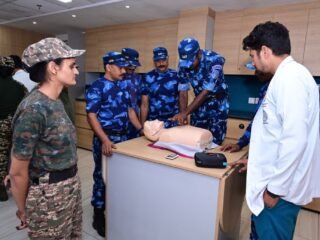New Delhi, 08 October, 2025: Punjabi singer Rajvir Jawanda passed away at the age of 35 after being on a ventilator for 11 days following a severe road accident. The news has shocked fans and raised renewed concerns about the devastating consequences of traumatic brain and spinal cord injury in high-impact collisions. While initial reports described his hospitalization and ventilator support, many questions remain about the nature and extent of his injuries. In this article, we explore what happens to the brain and spinal cord in such trauma, typical symptoms, the medical interventions involved, and how outcomes depend on rapid response and care
Punjabi Singer Rajvir Jawanda Dies At 35
The details emerging so far paint a grim scenario. Rajvir was involved in a serious road crash that left him critically injured. He was admitted to an intensive care unit and placed on a ventilator, likely due to respiratory failure or inability to breathe unaided. After 11 days of intensive care, he succumbed to complications related to his injuries.
While the full medical report is not publicly available, this pattern—severe accident, ventilator dependence, protracted ICU stay—suggests major damage to the central nervous system. In many road accidents, traumatic brain injury (TBI) and spinal cord injury (SCI) often co-exist, compounding the challenges of management and recovery.
Understanding Brain Injury in Road Crashes
When a person experiences a high-velocity impact, the brain undergoes rapid acceleration or deceleration within the skull. This can lead to several types of traumatic injury:
1. Diffuse Axonal Injury (DAI)
- Occurs when nerve fibers (axons) are stretched or torn during the forceful motion.
- Causes widespread disruption of brain signaling and may lead to coma or persistent vegetative states.
2. Intracranial Hemorrhage / Bleeding
- Epidural hematoma (between skull and dura mater), subdural hematoma (beneath the dura), or intracerebral hemorrhage (within brain tissue) can develop.
- These bleedings increase intracranial pressure, compress brain tissue, and can rapidly become fatal if not relieved surgically.
3. Contusions and Bruising
- Localized bruises form in coup or contrecoup regions (site of impact and the opposite side) causing swelling, edema, and secondary injury.
4. Secondary Injury
- After the initial mechanical insult, a cascade of inflammation, oxidative stress, reduced blood flow, and swelling can worsen the damage.
Symptoms of serious brain injury include loss of consciousness, severe headache, nausea/vomiting, confusion or disorientation, seizures, unequal pupil size, and changes in breathing or agitation.
In Rajvir’s case, being on a ventilator suggests that his brainstem or the neural pathways controlling respiration could have been compromised, or that pulmonary support was needed while the brain recovered.
Spinal Cord Injury: Why It Matters
The spinal cord extends from the brainstem through the vertebral column, and any fracture, displacement, or direct injury can disrupt communication between the brain and the body.
Types of Spinal Cord Damage
- Complete injury: Loss of all motor and sensory functions below the injury level.
- Incomplete injury: Some nerve function remains.
Effects Depending on Location
- A cervical (neck) injury can cause quadriplegia (affecting arms and legs), with breathing difficulty if high enough.
- Thoracic or lumbar injuries may cause paraplegia (legs only) or bowel/bladder dysfunction.
Signs of spinal cord injury include:
- Loss of movement, sensation, or reflexes below the injury.
- Severe pain or pressure in the neck or back.
- Numbness or tingling (pins and needles) in hands, fingers, legs.
- Difficulty breathing (if chest muscles are involved).
- Loss of bladder or bowel control.
Given his ventilator dependence, it’s plausible Rajvir sustained a high cervical cord injury alongside his brain injury, which could compromise the respiratory muscles.
Medical Management: What Happens in ICU
When brain and spinal injuries coexist, critical care becomes enormously complex. Key elements of management include:
Stabilization and Surgery
- Rapid airway protection and mechanical ventilation.
- Surgical decompression to relieve pressure from hemorrhages or fractured vertebrae.
- Spinal stabilization using rods, screws, or bone grafts to prevent further injury.
Intracranial Pressure (ICP) Management
- Use of osmotic agents (mannitol, hypertonic saline) to draw fluid out of the brain.
- Sedation, head elevation, and controlled ventilation to reduce brain swelling.
- Drainage of cerebrospinal fluid (CSF) if possible (ventricular drains).
Neurological Monitoring & Supportive Care
- Frequent imaging (CT/MRI) to track hemorrhage, swelling, or ischemia.
- Continuous monitoring of vital signs, oxygen levels, and neurological status.
- Nutritional support, infection prevention, and physiotherapy to reduce complications.
Rehabilitation & Long-Term Therapy
- After stabilization, patients require prolonged physiotherapy, occupational therapy, and sometimes neurorehabilitation.
- Focused efforts on regaining movement, sensation, and daily function if feasible.
- Psychological support for patients and families.
Prognosis: Why Outcomes Vary Widely
The outcome after combined brain and spinal injuries depends on several factors:
- Severity and Level of Injury
- Larger hemorrhages, more widespread brain damage, or spinal cord transection imply a worse prognosis.
- Speed and Quality of Care
- Rapid surgical intervention, good ICU practices, and neurocritical support significantly improve survival and outcome.
- Age & Health Status
- Younger patients with fewer comorbidities tend to recover better.
- Extent of Secondary Injury
- Minimizing swelling, stabilizing blood pressure, and safeguarding blood flow are critical in preventing further damage.
In many cases, even with best care, complete neurological recovery is unlikely if severe injury has already occurred. However, rehabilitation can help improve forms of residual function, adaptation, and quality of life.
Given Rajvir’s prolonged ventilator course and subsequent death, it is likely that the primary damage was severe and extensive, leaving little room for recovery despite intensive care.
Recognizing the Warning and Raising Awareness
Tragic cases like this highlight the importance of prevention, rapid response, and infrastructure readiness:
- Helmet use, seat belts, safe driving and improved road safety can prevent many head and spinal injuries in the first place.
- Prompt emergency services, trauma care units, and neurosurgical centers are essential in every region to reduce delays.
- Public education around recognizing signs of brain and spinal injury — unconsciousness, severe pain, paralysis — is vital.
- Post-accident protocols must include thorough neurological assessment and imaging to catch hidden injuries.
The passing of Rajvir Jawanda is a deeply tragic reminder of how a singular road accident can cascade into catastrophic damage to the most delicate organs — the brain and spinal cord. While we mourn a promising life cut short, we must also draw lessons about trauma awareness, improved care systems, and the frailty of the central nervous system.
In the hours, days, and weeks that follow a severe crash, every second counts. That window of neuro-protection, stabilization, and surgical care can mean the difference between survival, disability, or death. While not all outcomes are salvageable, better infrastructure, rapid intervention, and public awareness can reduce the toll of such tragedies and preserve more lives from the silent injury within the skull and spine.







